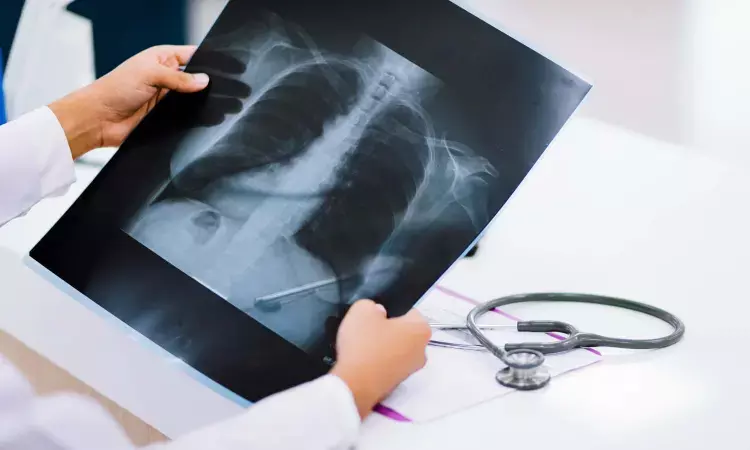- Home
- Medical news & Guidelines
- Anesthesiology
- Cardiology and CTVS
- Critical Care
- Dentistry
- Dermatology
- Diabetes and Endocrinology
- ENT
- Gastroenterology
- Medicine
- Nephrology
- Neurology
- Obstretics-Gynaecology
- Oncology
- Ophthalmology
- Orthopaedics
- Pediatrics-Neonatology
- Psychiatry
- Pulmonology
- Radiology
- Surgery
- Urology
- Laboratory Medicine
- Diet
- Nursing
- Paramedical
- Physiotherapy
- Health news
- Fact Check
- Bone Health Fact Check
- Brain Health Fact Check
- Cancer Related Fact Check
- Child Care Fact Check
- Dental and oral health fact check
- Diabetes and metabolic health fact check
- Diet and Nutrition Fact Check
- Eye and ENT Care Fact Check
- Fitness fact check
- Gut health fact check
- Heart health fact check
- Kidney health fact check
- Medical education fact check
- Men's health fact check
- Respiratory fact check
- Skin and hair care fact check
- Vaccine and Immunization fact check
- Women's health fact check
- AYUSH
- State News
- Andaman and Nicobar Islands
- Andhra Pradesh
- Arunachal Pradesh
- Assam
- Bihar
- Chandigarh
- Chattisgarh
- Dadra and Nagar Haveli
- Daman and Diu
- Delhi
- Goa
- Gujarat
- Haryana
- Himachal Pradesh
- Jammu & Kashmir
- Jharkhand
- Karnataka
- Kerala
- Ladakh
- Lakshadweep
- Madhya Pradesh
- Maharashtra
- Manipur
- Meghalaya
- Mizoram
- Nagaland
- Odisha
- Puducherry
- Punjab
- Rajasthan
- Sikkim
- Tamil Nadu
- Telangana
- Tripura
- Uttar Pradesh
- Uttrakhand
- West Bengal
- Medical Education
- Industry
Bendy X-ray detectors could revolutionize cancer treatment

New materials developed at the University of Surrey could pave the way for a new generation of flexible X-ray detectors, with potential applications ranging from cancer treatment to better airport scanners.
Traditionally, X-ray detectors are made of heavy, rigid material such as silicon or germanium. New, flexible detectors are cheaper and can be shaped around the objects that need to be scanned, improving accuracy when screening patients and reducing risk when imaging tumours and administering radiotherapy.
Dr Prabodhi Nanayakkara, who led the research at the University of Surrey, said:
“This new material is flexible, low-cost, and sensitive. But what’s exciting is that this material is tissue equivalent. This paves the way for live dosimetry, which just isn’t possible with current technology.”
Most of the X-ray detectors on the market today are heavy, rigid, energy-consuming and expensive if a large area needs to be covered.
Substances built up of hydrogen and carbon, known as organic semiconductors, offer a more flexible solution, but until now, did not allow as detailed an X-ray image to be produced as traditional detectors.
To solve this challenge, scientists at the University of Surrey's Advanced Technology Institute created devices based on an ink by adding low quantities of high atomic number elements to an organic semiconductor.
Building on the team’s previous research in this field, their new detector behaves more like human tissue under X-rays, which could lead to new, safer techniques for administering radiotherapy, mammography and radiography. Their findings are published in the journal Advanced Science.
Professor Ravi Silva, director of Surrey's Advanced Technology Institute, said:
“This new technology could be used in a variety of settings, such as radiotherapy, scanning historical artefacts and in security scanners. The University of Surrey together with its spin out SilverRay Ltd continues to lead the way in flexible X-ray detectors – we're pleased to see the technology shows real promise for a range of uses.”
Co-author, Professor Martin Heeney, Imperial College London, commented:
“We have been developing heavy analogues of traditional organic semiconductors for some time, and we were intrigued when Dr Imalka Jayawardena suggested their application in X-ray detectors. These results are very exciting, especially considering this was the first material investigated, and there is plenty of scope for further improvements.”
References:- M. Prabodhi A. Nanayakkara, Qiao He, Arvydas Ruseckas, Anushanth Karalasingam, Lidija Matjacic, Mateus G. Masteghin, Laura Basiricò, Ilaria Fratelli, Andrea Ciavatti, Rachel C. Kilbride, Sandra Jenatsch, Andrew J. Parnell, Beatrice Fraboni, Andrew Nisbet, Martin Heeney, K. D. G. Imalka Jayawardena, S. Ravi P. Silva https://doi.org/10.1002/advs.202304261
Dr Kamal Kant Kohli-MBBS, DTCD- a chest specialist with more than 30 years of practice and a flair for writing clinical articles, Dr Kamal Kant Kohli joined Medical Dialogues as a Chief Editor of Medical News. Besides writing articles, as an editor, he proofreads and verifies all the medical content published on Medical Dialogues including those coming from journals, studies,medical conferences,guidelines etc. Email: drkohli@medicaldialogues.in. Contact no. 011-43720751


